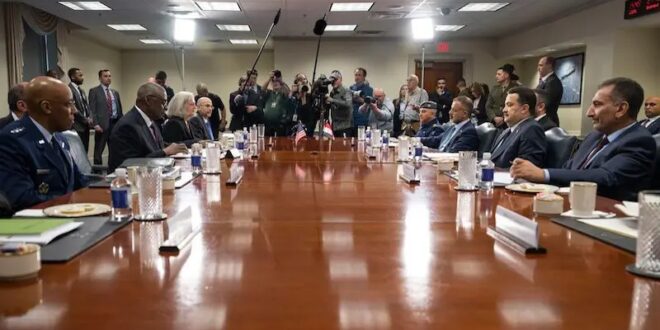An important story that could have implications for Middle East security is not getting the attention it deserves: the future of the US military presence in Iraq, where about 2,500 American troops are stationed.
They are part of an international operation to prevent the resurgence of Daesh. A significant portion of this mission involves joint operations with local forces, including the Iraqi Security Forces. Writing from America, I can tell you that the US military presence in Iraq rarely makes headlines. Furthermore, there has been no meaningful debate about America’s presence in Iraq during the US presidential campaign.
However, behind the scenes, the US and Iraqi governments have been in continuous discussion of the issue. A total withdrawal of US forces, as in Afghanistan in August 2021, is unlikely. Instead, the US will probably transition away from combat operations, with the troop presence evolving into a more traditional US-Iraq security partnership.
So far there is no timeline for US troops to leave and agreement between Washington and Baghdad have been progressing slowly. This is because several factors must be considered before any final decision can be made.
The first is the reemerging threat of Daesh. After suffering defeat in 2019, Daesh has been rebounding. In the first half of this year, it carried out 153 attacks in Iraq and Syria, double the number from the same period in 2023. A total of 196 counterterrorism operations targeting Daesh were carried out in the first half of 2024, with the vast majority — 137 operations —in Iraq. Clearly the threat is increasing and cannot be ignored.
Second, regional geopolitics, particularly concerning Iran, must be considered. While the American military presence in Iraq is primarily focused on counterterrorism, it would be naive to think that Iran’s increasingly aggressive role in the region isn’t also a factor. In recent months, Iran and its proxies have stepped up their attacks. This will undoubtedly influence US policymakers. Although Baghdad may never admit it publicly, it will be a consideration for them too. Also, the US military presence in Iraq cannot be viewed in isolation. If the US wants to continue its military presence in northern Syria to fight Daesh then it must maintain a military footprint in Iraq for logistical reasons.
Third, the Iraqi army’s capabilities must be evaluated. After its calamitous breakdown in 2014 in the face of Daesh’s onslaught on Mosul, a lot of progress has been made. With the help of international forces, the army played an instrumental role in the liberation of northern Iraq from Daesh. However, it is still largely reliant on US assistance to carry out counterterrorism operations. For example, last year the army conducted only five independent counterterrorism operations against Daesh without coalition assistance. Considering the increase in Daesh activity in Iraq, the army still has a long way to go before it can fully take over the counterterrorism mission.
Finally, Washington and Baghdad will want to coordinate with NATO. Many may not realize that NATO conducts a training mission in Iraq, and relations between Iraq and NATO have been deepening in recent years. Gen. Michael Kurilla, head of US Central Command, told Congress this year that any decision to withdraw US forces from Iraq would be taken in close coordination with NATO. Iraq’s national security adviser, Qasim Al-Araji, visited NATO last week to discuss improving relations with Baghdad and the ongoing and future NATO training mission in the country.
With all these factors in mind, it’s clear that a US withdrawal from Iraq in a realistic timeframe will not occur soon. There was some talk of aiming for the end of this year, but the geopolitical circumstances and logistical challenges make this unlikely, if not irresponsible. While there is no formal agreement between Washington and Baghdad, discussions will continue. However, like the rest of the world, Iraq’s government will be closely watching what happens in the US at the presidential election in November. Regardless of the outcome, Joe Biden will be presiding over a lame-duck administration, making it unlikely that Baghdad would want to finalize talks with the White House on such an important matter knowing there will be a new president by January 2025.
There is no doubt that both Americans and Iraqis would prefer to see most US troops withdrawn from Iraq. However, it must be done in a responsible and realistic way. The last thing that Iraq or the broader region needs is a repeat of Barack Obama’s withdrawal in 2011. Despite experts calling for the US to leave behind a small residual force to help the Iraqi army, Obama was determined to remove all troops to fulfill a campaign promise. Within three years, Daesh had captured a huge chunk of northern Iraq, and the Iraqi military had largely disintegrated. Before long, US troops were back in Iraq fighting Daesh, where they remain.
It is in the interest of both sides that the US-Iraq military relationship evolves into a more traditional security partnership. But the timeframe for this must be determined by the realities on the ground, not by wishful thinking.
 Eurasia Press & News
Eurasia Press & News


